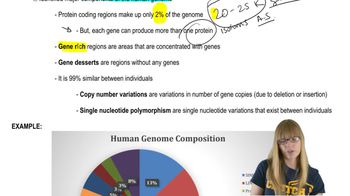Consider possible societal and ethical dilemmas that might arise if we currently shared the planet with another hominin.
Table of contents
- 1. Introduction to Genetics51m
- 2. Mendel's Laws of Inheritance3h 37m
- 3. Extensions to Mendelian Inheritance2h 41m
- 4. Genetic Mapping and Linkage2h 28m
- 5. Genetics of Bacteria and Viruses1h 21m
- 6. Chromosomal Variation1h 48m
- 7. DNA and Chromosome Structure56m
- 8. DNA Replication1h 10m
- 9. Mitosis and Meiosis1h 34m
- 10. Transcription1h 0m
- 11. Translation58m
- 12. Gene Regulation in Prokaryotes1h 19m
- 13. Gene Regulation in Eukaryotes44m
- 14. Genetic Control of Development44m
- 15. Genomes and Genomics1h 50m
- 16. Transposable Elements47m
- 17. Mutation, Repair, and Recombination1h 6m
- 18. Molecular Genetic Tools19m
- 19. Cancer Genetics29m
- 20. Quantitative Genetics1h 26m
- 21. Population Genetics50m
- 22. Evolutionary Genetics29m
22. Evolutionary Genetics
Phylogenetic Trees
Problem D.9
Textbook Question
How can ancient DNA provide insight into past migrations that analyses of extant human genomes fail to uncover?
 Verified step by step guidance
Verified step by step guidance1
Understand that ancient DNA (aDNA) refers to genetic material extracted from the remains of organisms that lived in the past, often thousands of years ago, providing a direct snapshot of genetic variation at specific points in history.
Recognize that analyses of extant (currently living) human genomes only reflect the genetic diversity of present-day populations, which may have been shaped by recent migrations, genetic drift, and admixture events, potentially obscuring older migration patterns.
Learn that by comparing ancient DNA sequences with those of modern populations, researchers can identify genetic lineages and population structures that no longer exist or are rare today, revealing migration events that left little or no trace in modern genomes.
Use ancient DNA to track changes in allele frequencies over time and to detect the arrival or disappearance of genetic variants associated with specific geographic regions, thereby reconstructing migration routes and timings more accurately.
Combine ancient DNA data with archaeological and environmental evidence to build a comprehensive picture of human migration history, overcoming limitations of studies based solely on extant genomes.
 Verified video answer for a similar problem:
Verified video answer for a similar problem:This video solution was recommended by our tutors as helpful for the problem above
Video duration:
2mPlay a video:
Was this helpful?
Key Concepts
Here are the essential concepts you must grasp in order to answer the question correctly.
Ancient DNA (aDNA) Analysis
Ancient DNA refers to genetic material extracted from archaeological and historical specimens. It allows direct study of past populations, revealing genetic information that predates modern groups. This helps reconstruct evolutionary history and population dynamics that are not evident from living genomes alone.
Recommended video:
Guided course

Chi Square Analysis
Limitations of Extant Human Genome Analysis
Analyses of modern human genomes reflect only surviving lineages and recent admixture events, potentially missing extinct or rare ancestral populations. Genetic drift, bottlenecks, and gene flow can obscure signals of ancient migrations, making it difficult to fully reconstruct past demographic events using only current genomes.
Recommended video:
Guided course

Human Genome Composition
Population Migration and Genetic Signatures
Migrations leave distinct genetic markers such as haplogroups and allele frequency shifts in populations. Ancient DNA can capture these signatures directly from past individuals, providing clearer evidence of migration routes, timing, and interactions between groups that may be diluted or lost in modern populations.
Recommended video:
Guided course

New Alleles and Migration
Related Videos
Related Practice
Textbook Question
462
views


